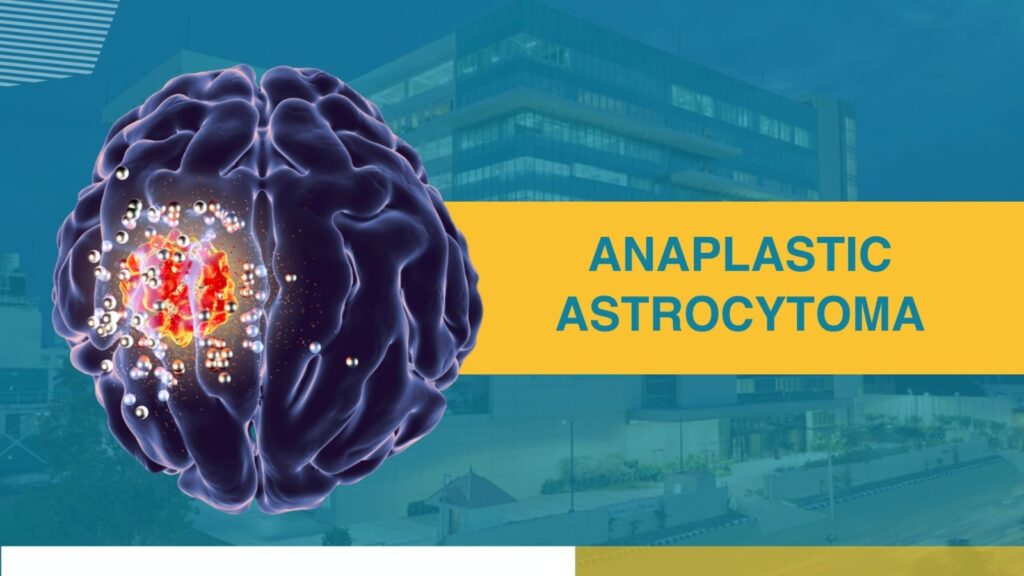Anaplastic Astrocytoma: Understanding This Rare Brain Tumor
What is Anaplastic Astrocytoma?
Anaplastic astrocytoma is a type of brain tumour that develops from astrocytes, which are supportive cells in the brain. It is a grade III astrocytoma, which means it is a more aggressive and rapidly growing tumour than lower-grade astrocytoma.
Seizures, headaches, changes in personality or behaviour, and weakness or numbness in specific parts of the body are all symptoms of an anaplastic astrocytoma. Anaplastic astrocytoma is typically treated with surgery to remove as much of the tumour as possible, followed by radiation therapy and chemotherapy. Anaplastic astrocytoma has a worse prognosis than lower-grade astrocytoma, but the outcome can vary depending on the individual case.
Why is it difficult to treat anaplastic astrocytoma?
Anaplastic astrocytoma is a rare type of brain tumour, but it is frequently aggressive and difficult to treat.
Anaplastic astrocytoma can be difficult to treat because it is frequently found in a part of the brain that is difficult to reach surgically. This can make it difficult for surgeons to completely remove the tumour, limiting the effectiveness of surgery as a treatment option.
Another factor that makes anaplastic astrocytoma difficult to treat is its resistance to chemotherapy and radiation therapy. These treatments are usually used to kill cancer cells, but they have a low success rate in treating anaplastic astrocytoma because the tumour cells are resistant to the drugs and radiation.
Furthermore, anaplastic astrocytoma can be difficult to treat due to its rapid growth and spread. This can make controlling the tumour and preventing it from spreading to other parts of the brain or spine difficult.
Overall, anaplastic astrocytoma treatment can be complicated, involving a combination of surgery, chemotherapy, and radiation therapy. The specific treatment approach will be determined by the size and location of the tumour, as well as the patient’s overall health and age.
The best treatment for anaplastic astrocytoma
The best treatment plan for an individual with anaplastic astrocytoma will be determined by a number of factors, including the tumors location and size, the patient’s overall health, and the potential risks and benefits of each treatment option.
Surgery is frequently used as the initial treatment for anaplastic astrocytoma. Surgery’s goal is to remove as much cancerous tissue as possible. A complete surgical resection (removal) of the tumour may be possible in some cases. Anaplastic astrocytomas, on the other hand, frequently have tentacles that extend into surrounding brain tissue, making complete removal difficult. In these cases, the surgeon may still remove as much of the tumour as possible in order to reduce its size and slow cancer growth.
To kill cancer cells, radiation therapy employs high-energy beams such as X-rays or protons. It can be administered either externally (from a machine outside the body) or internally (from a device placed inside the body near the tumor). Radiation therapy is frequently administered following surgery to eliminate any cancer cells that may remain in the area.
Chemotherapy employs the use of drugs to kill cancer cells. It can be administered orally (as a pill) or intravenously (through a vein). Chemotherapy is typically administered following surgery and radiation therapy to eliminate any remaining cancer cells and reduce the risk of cancer recurrence.
Is proton beam therapy effective for treating anaplastic astrocytoma?
PBT is a type of radiation therapy that employs a beam of protons (positively charged particles) to kill cancer cells. It is similar to traditional radiation therapy in that it uses X-rays to treat cancer, but it has some distinguishing features that may make it an effective treatment option in certain circumstances.
One potential advantage of proton beam therapy is that it can deliver a high dose of radiation directly to the tumor while minimizing exposure to surrounding healthy tissue. This is because the protons in the beam lose energy as they travel through the body, and they stop at a precise point within the body, called the Bragg peak. This allows the radiation to be more targeted to the tumor, reducing the risk of side effects.
Because the brain is a sensitive organ and radiation exposure to healthy brain tissue can have significant side effects, proton beam therapy may be especially useful for treating brain tumours such as anaplastic astrocytoma. It is important to note, however, that proton beam therapy is not without risks, and the potential benefits and risks should be carefully considered with the assistance of a healthcare team.
It’s also worth noting that proton beam therapy is not widely available due to the specialised equipment and trained personnel required. It is typically only available at a few specialised centres worldwide. Apollo Proton Cancer Centre is the only advanced comprehensive cancer centre with Proton Beam Therapy in South Asia and Middle East. A ray of hope for 3.5 billion people across 147 countries.
Surgery for treating anaplastic astrocytoma
The purpose of surgery is to remove as many cancerous tissues as possible.
The type of surgery required will be determined by the location and size of the tumour, as well as the patient’s overall health. A complete surgical resection (removal) of the tumour may be possible in some cases. Anaplastic astrocytoma, on the other hand, frequently has tentacles that extend into surrounding brain tissue, making complete removal difficult. In these cases, the surgeon may still remove as much of the tumour as possible to reduce its size and slow its growth.
A neurosurgeon, a doctor who specialises in brain and nervous system surgery, typically performs the procedure. The surgery can be performed via an open incision in the skull (craniotomy) or via a minimally invasive approach, such as stereotactic radiosurgery or stereotactic biopsy.
It is critical to understand that surgery for anaplastic astrocytoma carries significant risks and potential complications, such as bleeding, infection, and damage to surrounding brain tissue. With the assistance of a healthcare team, the potential benefits and risks should be carefully considered.
Chemotherapy for treating anaplastic astrocytoma
Chemotherapy is a type of cancer treatment that employs the use of drugs to destroy cancer cells. It is typically administered following surgery and radiation therapy to eliminate any remaining cancer cells and reduce the risk of the cancer returning.
Alkylating agents, antimetabolites, and platinum-based drugs are among the chemotherapy drugs that may be used to treat anaplastic astrocytoma. The chemotherapy regimen (treatment schedule) used will be determined by a number of factors, including the patient’s overall health, the characteristics of the tumour, and the potential side effects of the chemotherapy drugs.
Chemotherapy is typically administered orally (via pill) or intravenously (through a vein). It is typically administered in cycles, with each cycle consisting of a treatment period followed by a rest period. The length of treatment and the number of cycles will be determined by the chemotherapy regimen used.
It is important to note that chemotherapy can cause serious side effects such as nausea, vomiting, hair loss, and an increased risk of infection. These side effects are frequently manageable with medications or other forms of supportive care. Chemotherapy’s potential benefits and risks should be carefully considered with the assistance of a healthcare team.
Radiation for anaplastic astrocytoma
Radiation therapy is a type of cancer treatment that kills cancer cells by using high-energy beams such as X-rays or protons. It is frequently administered following surgery to eliminate any cancer cells that may have remained in the area.
External beam radiation therapy and brachytherapy are two types of radiation therapy that can be used to treat anaplastic astrocytoma.
The most common type of radiation therapy for brain tumours is external beam radiation therapy. It entails using a machine to deliver high-energy radiation beams from outside the body to the tumour. It is typically administered in daily doses over a period of several weeks.
Brachytherapy entails inserting a device containing radioactive seeds or rods into the body near the tumour. The device is typically left in place for a few days before being removed.
The type of radiation therapy used and the amount of radiation administered will be determined by a number of factors, including the location and size of the tumour, the patient’s overall health, and the potential risks and benefits of each treatment option.
It’s important to understand that radiation therapy can cause fatigue, skin irritation, and an increased risk of infection. These side effects are frequently manageable with medications or other forms of supportive care. Radiation therapy’s potential benefits and risks should be carefully considered with the assistance of a healthcare team.
Radiation versus Proton Beam Therapy for treating anaplastic astrocytoma
Both radiation therapy and proton beam therapy can be used to treat anaplastic astrocytoma. High-energy beams are used in both approaches to kill cancer cells and shrink tumours. There are, however, some significant differences between the two approaches:
- Radiation type: Radiation therapy delivers radiation to the tumour using high-energy photons or particles such as x-rays or electrons. Proton Beam Therapy delivers radiation using protons, which are positively charged particles.
- Dosage: Proton Beam Therapy allows for more precise radiation dose delivery, allowing for higher doses to be delivered to the tumour while minimising exposure to healthy tissue. This is especially useful in the brain, where normal tissue is highly sensitive to radiation.
- Adverse effects: Both radiation therapy and PBT can cause fatigue and skin irritation. However, because proton beam therapy delivers radiation more precisely, it may have fewer side effects overall.
- Availability: Proton beam therapy is less widely available than traditional radiation therapy and may not be available at all cancer treatment centres.
Finally, the choice of treatment will be determined by the specific characteristics of the patient’s tumour as well as the overall treatment plan. To determine the best course of action, it is critical to discuss all treatment options with a medical team.
Types of anaplastic astrocytoma
Anaplastic astrocytoma has several subtypes, including:
- Anaplastic astrocytoma with molecular IDH wildtype: Unlike other types of gliomas, this subtype of anaplastic astrocytoma lacks a specific genetic mutation.
- Anaplastic astrocytoma with molecular IDH mutant: This anaplastic astrocytoma subtype has a specific genetic mutation known as IDH (isocitrate dehydrogenase) that is frequently seen in other types of gliomas.
- Anaplastic astrocytoma with 1p/19q co-deletion: This subtype of anaplastic astrocytoma is distinguished by a specific genetic mutation involving the deletion of portions of chromosomes 1 and 19. This mutation has been linked to a better prognosis in other types of gliomas.
It is important to note that genetic testing can determine the subtypes of anaplastic astrocytoma, which can then be used to guide treatment decisions. However, the subtype of anaplastic astrocytoma does not always determine a person’s overall prognosis or outcome from this type of brain tumour. The treatment and prognosis for anaplastic astrocytoma are determined by a number of factors, including the size and location of the tumour, the person’s overall health, and the treatment’s effectiveness.
Is anaplastic astrocytoma hereditary?
Anaplastic astrocytoma is a rare type of brain tumour that is not inherited. It is a cancer that develops from astrocytes, which are brain and spinal cord cells that support nerve cells. These tumours can be aggressive and grow quickly, but they are not usually passed down from parent to child.
Neurofibromatosis type 1 (NF1) and Li-Fraumeni syndrome are two rare genetic conditions that can increase the risk of developing an anaplastic astrocytoma. The vast majority of anaplastic astrocytoma cases, however, occur in people with no known genetic risk factors.
It is important to note that, while anaplastic astrocytoma is not usually inherited, other types of brain tumours can be. If you have a family history of brain tumours or are concerned about your risk of developing one, talk to your doctor or a genetic counsellor. They can provide additional information and assist you in understanding your risk factors.
To know more about Proton Beam Therapy and Apollo Proton Cancer Centre, write to us at apollocancercentres@apollohospitals.com or call us on 1800 203 1066 / +91 40 48964515.






